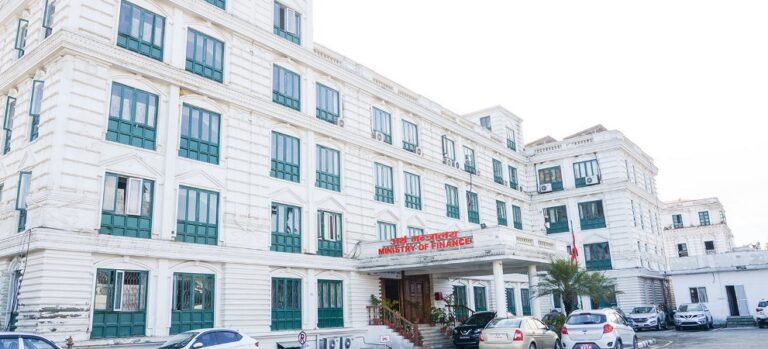
The white paper on the economic situation of the country as tabled in the House of Representatives by Finance Minister Janardan Sharma on Tuesday manifested a downgrading trend of the economic indicators. The following indicators reflect the current trends.
The economic growth contracted by 2.1 per cent in the fiscal year 2019/20 as against the targeted 8.5 per cent.
The agriculture sector contributed 26.8 per cent to the gross domestic product (GDP) in the FY 2016/17, however, it is expected to shrink by 25.8 per cent in the FY 2020/21.
Similarly, the industrial sector also seems dismal. Its contribution was 14 per cent of the GDP in the fiscal year 2016/17 whereas it is expected to be reduced to 13.1 percent in the FY 2020/21.
Meanwhile, the service sector is graduating with a contribution of 61.1 percent of GDP in 2020/21 up from 58.6 percent of the fiscal year 2016/17.
The contribution of the production-based industry consists of 5.1 percent of GDP which is not a robust cue.
Price situation
The average price inflation in FY 2016/17 was 4.4 per cent. The inflation was contained to 3.6 per cent in the FY 2020/21. The soaring fuel price might spike it further.
Consumption, saving and capital formation
The consumption pattern of Nepalis is expected to cross 93.4 per cent of the GDP up from 87 per cent in FY 2016/17.
The gross saving is expected to rise over 6.6 per cent in the fiscal year 2020/21 which is down from 13 per cent of the FY 2016/17.
The proportion of national savings to the gross domestic product is expected to cross 31.4 per cent in the fiscal year 2020/21 which is less than 41.7 per cent of the fiscal year 2016/17.
The proportion of fixed capital formation to the GDP is expected to cross 27.3 per cent which is down from 30.6 per cent of the FY 2016/17.
The contribution of the government sector in the fixed capital formation will be 4.9 per cent in the fiscal year 2020/21, 7.9 per cent down from 2016/17.
The government expenditure
The proportion of capital expenditure was 24.9 per cent when the aggregate expenditure of the federal government was Rs. 1087 billion in the FY 2017/18. However, the proportion of expenditure is expected to remain at 19.3 per cent when aggregate expenditure for the fiscal year 2020/21 crossed Rs. 1180 billion. Similarly, the proportion of the current expenditure in the fiscal year 2017/18 is 64.1 per cent of the aggregate expenditure while such an expenditure touched 72.1 per cent in the fiscal year 2020/21.
The proportion of capital expenditure stood 66.9 percent of the appropriated amount in the fiscal year 2016/17. The capital expenditure increased to 76.9 percent in the FY 2018/19. However, the capital expenditure decreased to 46.3 percent and 64.7 percent in 2019/20 and 2020/21 respectively.
The federal treasury position deficit was Rs. 48 billion in 2017 and in 2019/20 it crossed Rs. 216 billion. It is estimated to be in deficit by Rs. 143 billion.
Revenue mobilization
The revenue of the federal government stood at Rs. 829 billion out of aggregate revenue of Rs. 938 billion in the fiscal year 2020/21.
The aggregate revenue for FY 2020/21 is 22 percent of the GDP.
Foreign Trade
The import and export ratio was 48 percent in the fiscal year 2001 and has now declined to 9.2 percent by the end of the fiscal year 2019/20. The export increased to Rs. 141 billion in the fiscal year 2020/21 exporting 3.3 per cent of the gross domestic product.
The number of imports increased to Rs. 1540 billion that is 36.1 percent of the gross domestic product in the fiscal year 2020/21. The amount of import was Rs. 990 billion in 2016/17 which was 32.2 percent of gross domestic product.
The proportion of capital and industrial imports comprises 14.8 percent and 37.2 per cent respectively in FY 2020/21.
The balance of payment and foreign exchange reserve
The balance of payment was surplus by Rs. 282 billion in the FY 2017 however it has been deficit by Rs 15.15 billion in the fiscal year 2019/20 due to rising imports.
The foreign exchange reserve was Rs 1079 billion in 2018 while it increased to Rs. 1366 billion till mid-June 2020/21.
Remittance
The amount of remittance was Rs. 695 billion in 2018/19. It increased to Rs. 871 billion in the 11 months of the fiscal year 2020/21.
International development aid
The government took Rs. 149 billion as development aid in the fiscal year 2016/17. Now, the amount received has increased to Rs. 163 billion in the fiscal year 2020/21.
Public Debt
The public debt of the government was Rs. 698 billion that comprises 22.7 percent of GDP in the FY 2016/17. It has risen to Rs 1729 billion which is 40.5 per cent of the GDP. In the public debt, Rs. 801 billion is internal debt and Rs. 928 is external debt.
Financial sector
In the fiscal year 2017, the credit flow by commercial banks in the priority sectors like agriculture, energy consisted of 18.2 per cent. It has increased to 27.9 per cent in the fiscal year 2020/21.
Insurance sector
By the end of the fiscal year 2020/21, 27 percent of the population will have access to insurance facilities.
Capital Market
In the fiscal year 2019/20, capital in the market consists of 45.8 per cent of gross domestic product. However, in the fiscal year 2020/21, the share of the market capitalization of GDP increased to 98.8 percent.
Foreign investment
Net foreign investment in Nepal in FY 2017 was Rs. 13.50 billion while it was Rs. 16.20 billion in FY 2020/21.





